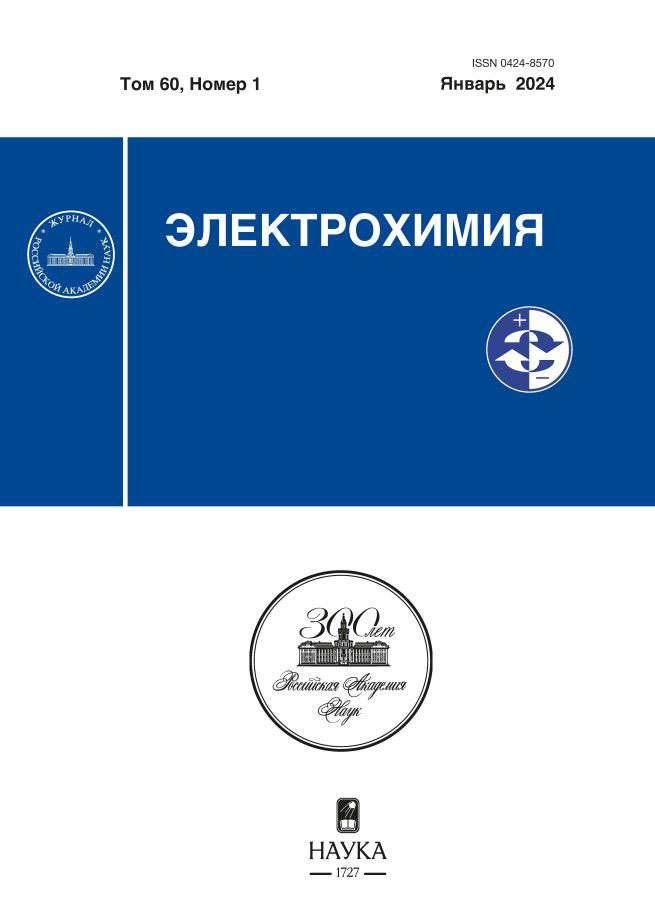An investigation of the electrical properties and microstructure of Ni/Ce0.8Gd0.2O2, composite-based anode for a solid oxide fuel cell fabricated by 3D printing
- Authors: Asmedianova A.D.1,2, Titkov A.I.1
-
Affiliations:
- Institute of Solid State Chemistry and Mechanochemistry, Siberian Branch, Russian Academy of Sciences
- Novosibirsk State University
- Issue: Vol 60, No 1 (2024)
- Pages: 79-84
- Section: Articles
- URL: https://cardiosomatics.ru/0424-8570/article/view/671770
- DOI: https://doi.org/10.31857/S0424857024010107
- EDN: https://elibrary.ru/GGCMMA
- ID: 671770
Cite item
Abstract
In this work, a series of planar anode billes for a solid oxide fuel cell based on NiO/Ce0.8Gd0.2O2 (NiO/GDC) was fabricated using the microdroplet 3D printing method with a pneumatic metering valve. The porosity and shrinkage coefficient during sintering of the anode billes, depending on the method of fabrication, have been investigated.
Anode billes were reduced in a hydrogen flow, and the effect of printing parameters on the morphological, structural, and electrochemical characteristics of NiO/Ce0.8Gd0.2O2 cermet was studied. The use of 3D printing was found to increase the porosity of the Ni/GDC composite from 7 to 23% as compared to that of the sample prepared by means of casting, while the value of electrical conductivity, (2.82 ± 0.06)·103 S/cm, remains high.
Full Text
About the authors
A. D. Asmedianova
Institute of Solid State Chemistry and Mechanochemistry, Siberian Branch, Russian Academy of Sciences; Novosibirsk State University
Author for correspondence.
Email: asmedianova@gmail.com
Russian Federation, Novosibirsk; Novosibirsk
A. I. Titkov
Institute of Solid State Chemistry and Mechanochemistry, Siberian Branch, Russian Academy of Sciences
Email: asmedianova@gmail.com
Russian Federation, Novosibirsk
References
- Tai, X.Y., Zhakeyev, A., Wang, H., Jiao, K., Zhang, H., and Xuan, J., Accelerating Fuel Cell Development with Additive Manufacturing Technologies: State of the Art, Opportunities and Challenges, Fuel Cells, 2019, vol. 19, no. 6, p. 636.
- Лебедева, М.В., Яштулов, Н.А. Топливные элементы – характеристика, физико-химические параметры, применение. Учеб. пособие. М.: Мир науки, 2020. Сетевое изд., с. 17.
- Modak, C.D., Kumar, A., Tripathy, A., and Sen, P., Drop impact printing, Nat. Commun., 2020, vol. 11, p. 4327.
- Bagishev, A., Titkov, A., Vorobyev, A., Borisenko, T., Bessmeltsev, V., Katasonov, D., and Nemudry, A., Development of composite electrode materials based on nickel oxide for additive manufacturing of fuel cells, MATEC Web of Conferences, 2021, vol. 340, p. 1115.
- Bagishev, A.S., Mal’bakhova, I.M., Vorob’ev, A.M., Borisenko, T.A., Asmedianova, A.D., Titkov, A.I., and Nemudryi, A.P., Layer-by-Layer Formation of the NiO/CGO Composite Anode for SOFC by 3D Inkjet Printing Combined with Laser Treatment, Russ. J. Electrochem., 2022, vol. 58, p. 600.
- Lv, Z., Huang, X., and Liu, X., Effect of Fuel Depletion on Ni-YSZ Anode Supported Membrane Fuel Cell Under Different Discharge Modes, ECS Trans., 2021, vol. 103, no. 1, p. 1059.
- Hussain, S. and Yangping, L., Review of solid oxide fuel cell materials: cathode, anode, and electrolyte, Energy Transitions, 2020, vol. 4, p.113.
- Gorte, R.J. and Vohs, J.M., Novel SOFC anodes for the direct electrochemical oxidation of hydrocarbons, J. Catalysis, 2003, vol. 216, p. 481.
- Steele, B.C.H., Appraisal of Ce1 – yGdyO2 – y/2 electrolytes for IT-SOFC operation at 500 оC, Solid State Ionics, 2000, vol. 129, no. 1–4, p. 95.
- Iwanschitz, B., Sfeir, J., Mai, A., and Schütze, M., Degradation of SOFC anodes upon redox cycling: a comparison between Ni/YSZ and Ni/CGO, J. Electrochem. Soc., 2010, vol. 157, no. 2, p. B269.
- Will, J., Mitterdorfer, A., Kleinlogel, C., Perednis, D., and Gauckler, L., Fabrication of thin electrolytes for second-generation solid oxide fuel cells, Solid State Ionics, 2000, no. 131, p. 79.
- Xiao, Guoliang and Chen, Fanglin, Redox Stable Anodes for Solid Oxide Fuel Cell, Frontiers in Energy Res., 2014, vol. 2, article 18, p. 1.
- Dr. de Haart, L.G.J., Solid Oxide Fuel Cells – Integrating Degradation Effects into Lifetime Prediction Models, New Energy World, 2014, p. 7.
- Grilo, João P.F., Macedo, Daniel A., Nascimento, Rubens M., and Marques, Fernando M.B., Assessment of NiO-CGO composites as cermet precursors, Solid State Ionics, 2018, vol. 321, p. 120.
- Gil, V., Moure, C., & Tartaj, J., Sinterability, microstructures and electrical properties of Ni/Gd-doped ceria cermets used as anode materials for SOFC, J. Europ. Ceram. Soc., 2007, vol. 27, p. 4208.
Supplementary files













